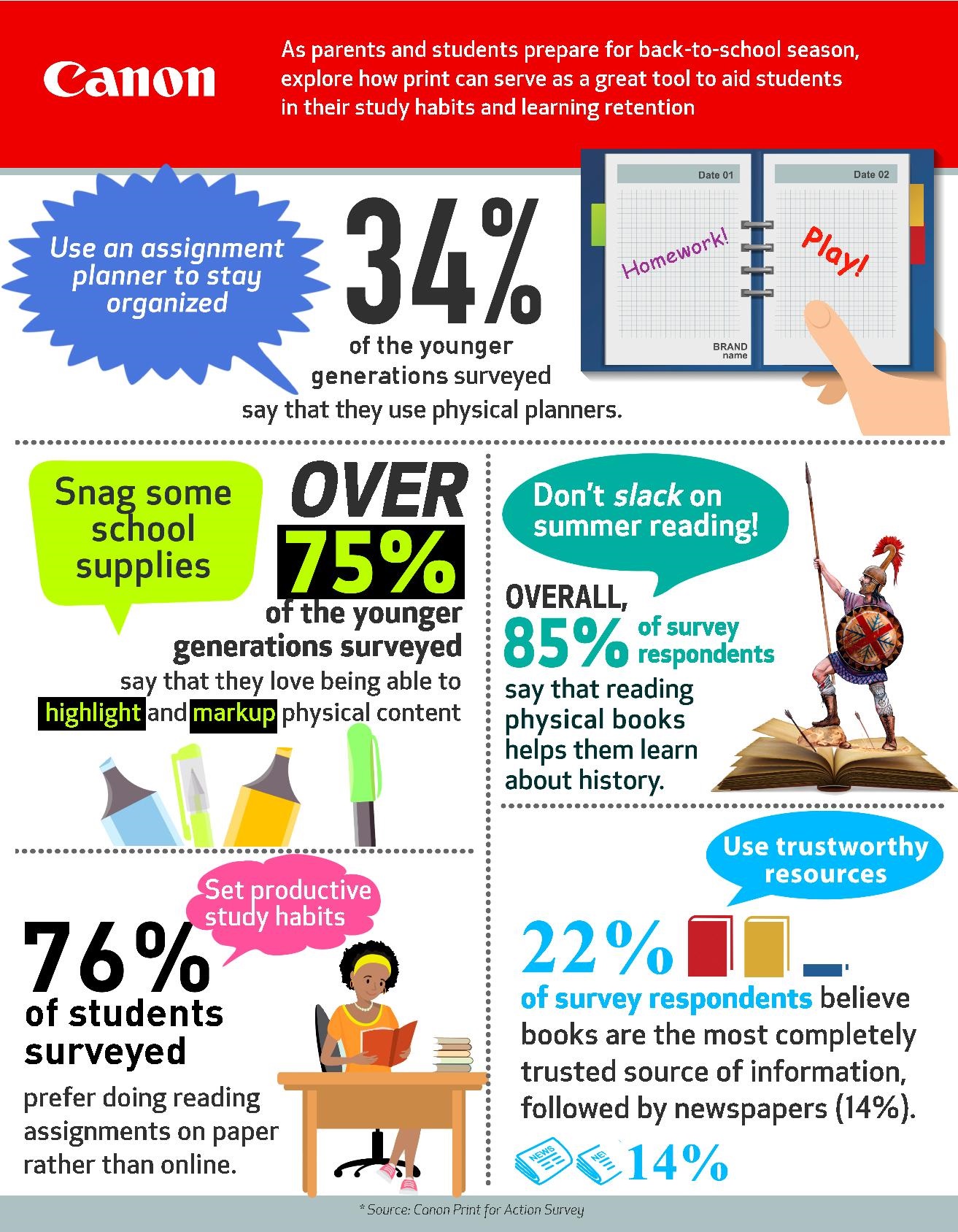As back-to-school season approaches, transitioning back into a study routine can be difficult— for both students and Moms. The power of print, however, can be a great tool to aid studies at home and successes in school, and help to stimulate their learning retention. In fact, 76% of students surveyed agree they prefer doing reading assignments on paper rather than online for better learning retention*. Below are a few examples as to how print as a medium can help your loved ones navigate the new school year, as told through recent survey results from the Canon Print for Action Survey conducted by Ipsos for Canon*.
Print plays a pivotal role in student education every day. From vibrant posters that decorate classroom walls to printed resources like homework planners, notebooks, and textbooks, the medium creates an environment that promotes learning and engagement both inside and outside the classroom setting.
Digital Can Be Detrimental
We live in a digital society, but devices in the classroom can easily be distracting and overwhelming according to 69% of survey respondents. Specifically, when it comes to studying habits and learning retention, 76% of students surveyed say they tend to perform better when using print rather than digital materials as study aids. So the next time your student is up late cramming for a hard history exam, suggest sitting down with them and their textbook. Speak to them about the material out loud as an added measure to help them digest the information presented on the pages in front of them.
Don’t Shy Away from Over Purchasing School Supplies
The right school supplies can improve a student’s learning retention—so make sure physical materials like assignment planners, colorful highlighters and note pads are on your back-to-school lists. Assignment planners encourage students to physically write down what assignments are due and when, and as it happens, 34% of the younger generations surveyed say they use physical planners to help them stay organized and on top of upcoming deadlines. And since over 75% of students surveyed say they love to highlight and mark up physical content, with a range of colorful highlighters and notepads, students can stop to note and recognize what is actually important within a text, rather than just scroll quickly through an online resource.
Find Value in Physical Resources
The information posted on social media and online news websites may not always be accurate. Help confirm data by suggesting an afternoon library trip with your future scholar for the next big research paper and encourage your student to check out a few books on the subject. Reading physical books can help students learn about history (85%) and develop problem-solving skills (74%)*, so urge your student to find value in physical books, as well as in print, to help them prepare for the harder classes on their roster this fall, and expand their research paper bibliographies beyond Wikipedia. After all, when compared to social media (6%) and online news websites (9%), survey respondents believe physical printed resources like books (22%) are the most completely trusted source of information, followed by newspapers (14%)*.
To learn additional key insights from the survey that speak to print’s versatility and positive influence in student education, please visit the Canon Print for Action resource guide.
*All figures, unless otherwise stated, are from an Ipsos survey conducted on behalf of Canon U.S.A., Inc. The survey was conducted online in English; fielding from November 27th – 29th, 2018 with a total sample size of 2,010 adults, ages 18 and older from the continental U.S., Alaska, and Hawaii. The results were weighted to match the 2016 U.S. census demographic data (including gender, age, region, race/ethnicity, and income) to help ensure the data is representative of the U.S. population. This study has a credibility interval of ±2.5 percentage points for all respondents. The following generational breaks were used when examining the data: Gen Z (21 and under), Millennials (22-36), Gen X (37-52), Baby Boomers (53-71), and Silent (72+) with the following sample sizes; Gen Z: 62, Millennials: 537, Gen X: 574, Baby Boomers: 689, Silent: 148.





